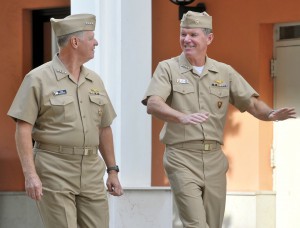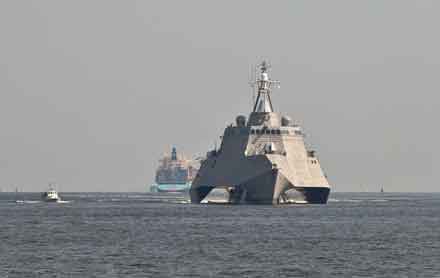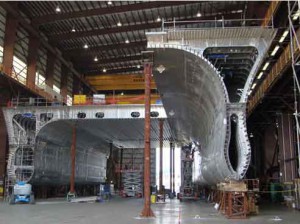An Exclusive Interview with the Chief of Naval Operations (CNO)
Reported by George Talbot

09/06/2011 – Recently, the CNO visited the LCS program at the Austal shipyards. Our colleague George Talbot had the chance to talk with the outgoing CNO about the recent past and the way ahead.
Admiral Gary Roughead calls it the “night in March.” It’s the moment he was asked by a dinner guest whether he, as the Navy’s Chief of Naval Operations since 2007, was staying true to the Navy’s maritime strategy.
“At that point, I knew we were going to Libya. The public did not. But I said to myself, okay, let’s think about this,” Roughead said.
“Our maritime strategy is six things:
- We’re going to be global.
- We’re going to be a deterrent force,
- exercise sea control,
- project power,
- conduct humanitarian assistance
- and provide maritime security.
“I look around and I’ve got ballistic missile submarines out on patrol. I’ve got two aircraft carriers in the Middle East as the changes are sweeping through the region. We were a deterrent force conventionally and strategically. We were moving ships in position to take out the entire air defense system of Libya. Those ships were on station, we just had to move them into launch position. We were also out there to provide sea control.
“Go a little farther east, we were conducting counter-piracy operations with 14 other countries. We were also launching strikes into Afghanistan. Then we had the Ronald Reagan strike group en route to Afghanistan to relieve one of our carriers. But within 24 hours, we said not so fast. We need you to go to Japan to conduct humanitarian assistance. And we brought our amphibious ships up from Australia.
“The point is, your Navy is out there, it’s forward and it is doing everything we need it to do. So I told this fellow at dinner, ‘Yes.’ All the things that we call for in our maritime strategy we’re delivering on today.”
Admiral Roughead shared those observations and more during a recent visit to Mobile, Alabama, where he toured the Austal USA shipyard and got a first-hand look at the two new classes of vessels – littoral combat ships and high-speed transport vessels – it is building for the Navy.
Admiral Roughead, 60, is retiring from the Navy on Sept. 29, to be replaced by Adm. Jonathan Greenert.

Admiral Roughead : « they are going to be a pirate's worst nightmare » USS Independence (LCS2) Builder's Sea Trials source: www.defpro.com
Q. What brought you back to Austal?
Admiral Roughead: This is my third visit in four years, so I’ve been able to see the evolution of the programs, and also the evolution of Austal. I’m very pleased with what I see, pleased with the team, pleased with what we’ve been able to do with the littoral combat ship, since my time as CNO. It’s good to see LCS 4 as far along as it is, and the progress with the Joint High Speed Vessel.
Q. The first two littoral combat ships were finished during your tenure, and you secured contracts for 20 more. Do you think the LCS will be part of your legacy?
Admiral Roughead: My legacy will be decided after I leave. But for me, getting the LCS to where it was stable, and the prices right, was something we had to do. Because the value of these ships, I think, is going to be off the scale. The capability, flexibility, efficiency and speed that they will be able to operate globally with is going to be an aspect of the Navy we haven’t had before. I think it’s going to be huge for us.
So getting this program “headed fair,” to use an old mariner’s term, was the highest priority for me when I became CNO, and I started at it pretty much from the get go. The first visit I made when I got into this was to a littoral combat ship.
Getting this program “headed fair,” to use an old mariner’s term, was the highest priority for me when I became CNO.
Q. Are you comfortable with where the program is now?
Admiral Roughead: I’m very comfortable with the program, with what I’ve seen the ships do operationally. And as a result of coming down here, I’m very comfortable with how the team, the Navy-industry team is positioning itself for good quality work, on-time work, on-cost work, getting the ships out, because we need them.
Q. How vulnerable is the LCS program to future Pentagon spending cuts?
Admiral Roughead: Having done this for a few years now, I learned in Washington that everything is vulnerable to budget pressure. But what I believe is important is that the value of the ship is seen, that the extraordinary process, effort and team in place here to build these is something that we as a nation should not jeopardize.
Our industrial base is how we produce the Navy that the nation uses. We often talk about the great service our people in uniform do, but I never for a moment lose sight of the fact that these ships are built by great Americans, great craftsmen who have extraordinary pride in what we do. If not for them, we would not have the ships with which we build the Navy. We need, I believe, to not lose sight of that.
Our industrial base is how we produce the Navy that the nation uses. We often talk about the great service our people in uniform do, but I never for a moment lose sight of the fact that these ships are built by great Americans, great craftsmen who have extraordinary pride in what we do. If not for them, we would not have the ships with which we build the Navy. We need, I believe, to not lose sight of that.
Q. Can you talk about the evolving mission of the LCS?
Admiral Roughead: Where we’re going, focusing on mine warfare, anti-submarine warfare, surface warfare, is exactly where we need the capability. That said, I believe that when these ships are in the hands of the sailors, you’re going to see things emerge, new capabilities emerge, from these ships. They’re going to be the workhorses of the Navy. The speed, the shallow draft allows us to get into places we haven’t been able to get into before, allows us to respond in ways haven’t been able to respond before.
The LCS will be used as staging bases for other services to work from. I’m a huge proponent of unmanned systems, and these ships will be a workhorse in that regard. They’ll have the ability to deploy not only unmanned aviation systems, but underwater systems, unmanned surface systems. It’s pretty much game-changer for us. This ship is perfectly suited to support those missions.
Q: You’ve got LCS 1 and 2 deployed. What are you hearing from the field?
Admiral Roughead: You know, it’s exciting because we’re learning more every day. The fact is these ships are going to be key across a range missions, because not only can they do the high end of warfare – they are going to be a pirate’s worst nightmare – and some cocaine smugglers have already found that out in the Caribbean.
They saw the LCS on the horizon, and they said we’ll put the hammer down and they won’t be able to catch us. And then this big ship caught them. Speed matters. They also didn’t expect that ship to go where it went. Draft matters. This ship will be brought in across that spectrum, and that’s why I find so much value in it.
Q. Are you comfortable with the progress the Navy has made with LCS mission packages?
Admiral Roughead: I am, but it’s important that we see mission modules as an evolutionary process. The technology, and the speed with which technology is produced today, will allow us to adjust those modules, advance them in ways that we really would not be able to do if that capability were permanently installed in the ship.
We can have a module out ashore, doing complete upgrades to it, and not have the ship not tied up, which is what happens today. So the modular concept, what we’ve done with the mission packages, is exactly the right way to go to be able to accelerate the type of technology that I think is going to continue to come down the pipe in the future. The open architecture gives us that flexibility.
The modular concept, what we’ve done with the mission packages, is exactly the right way to go to be able to accelerate the type of technology that I think is going to continue to come down the pipe in the future. The open architecture gives us that flexibility.
Q. Flexibility translates to relevancy.
Admiral Roughead: Exactly. What happens in maintaining relevancy – when you do upgrades there’s always a cost to that, and much of the cost of the more conventional types of ships is all the work has to be done on ships themselves, and the cost of not being able to use those ships while they’re tied up, and you avoid that with LCS.

Q. What capabilities will the JHSV high-speed transport ships add to the fleet?
Admiral Roughead: What JHSV will give us is a means, at much less cost than what we’ve been able to achieve to this point, to be able to operate and support forces in remote areas and unimproved areas, to be able to move things very quickly. As you know, we have the USS Swift (HSV 2), which is a variation on a high-speed vessel. We also use a high-speed vessel out in the western Pacific in support of the Marines. We actually reached in and used the Hawaii Superferries to perform some of the humanitarian assistance in Haiti, following the earthquake there.
I see them being in great demand in more benign environments, but being able to reach out and engage in areas that we would not necessarily have the infrastructure to do. The volume and capability of the JHSV, the way that we are going to man them – it’s a very efficient way to operate our Military Sealift Command.
The Navy will have the whole JHSV fleet, which I think is right way to operate. Not that the Army was not ready to do it, but we would have had the same ships being operating in two different models, two different funding streams. This allows us to be much more efficient in scheduling and usage. Look, we’re going to work them hard. If what we’ve done with the Swift and the Westpac Express (HSV 4676), which are the two high-speed vessels we use now, are any indication, they are going to be underway a lot and are going to be being used a lot.
Q. You met with the crew and the Austal team in Mobile. What was your message to them?
Admiral Roughead: I thanked them for what they were doing. Not just the uniformed guys, but the contractors as well. I’ve put a couple ships in commission myself, and the effort put into bringing a ship along, making sure the quality is there, that people understand how it’s supposed to be operated, that sets the tone for all the years that follow. If you start them bad, you get them bad, but conversely if you start good, you get them good. The team sets the course for ship, I’ve seen it time and time again. It’s hard work building a ship, manning it and bringing to life, and I wanted to thank them for what they’re doing.
The team sets the course for ship, I’ve seen it time and time again. It’s hard work building a ship, manning it and bringing to life.
Q: What’s impressed you about the facility?
Admiral Roughead: What I saw today, particularly looking at the improvements, the productivity gains between LCS 2 and LCS 4 are pretty extraordinary. Everything that has been done here from the physical plant to investing in people and really putting in place processes that are somewhat unique to the shipbuilding business, that’s where the payoff is going to come from. In that payoff, we’ll get the best schedule and the best cost, which will allow us to continue down the path and sets the stage for other things to follow.
The other thing, what we in the Navy are doing, we’re controlling our appetites as well. We’re making sure the changes we want done are absolutely necessary for safety or mission accomplishment. I’m hopeful that the shipbuilder is seeing the benefit of us sitting on requirements. It’s all about keeping an eye toward what we are trying to do, and that’s get ships out into fleet.
Q: What’s impressed you about the facility?
Admiral Roughead: What I saw today, particularly looking at the improvements, the productivity gains between LCS 2 and LCS 4 are pretty extraordinary. Everything that has been done here from the physical plant to investing in people and really putting in place processes that are somewhat unique to the shipbuilding business, that’s where the payoff is going to come from. In that payoff, we’ll get the best schedule and the best cost, which will allow us to continue down the path and sets the stage for other things to follow.
The other thing, what we in the Navy are doing, we’re controlling our appetites as well. We’re making sure the changes we want done are absolutely necessary for safety or mission accomplishment. I’m hopeful that the shipbuilder is seeing the benefit of us sitting on requirements. It’s all about keeping an eye toward what we are trying to do, and that’s get ships out into fleet.
Q: Going forward, how can the Navy continue to cut costs without sacrificing its mission?
Admiral Roughead: We’ve looked at a series of things we can do. Last year we took a lot of money out because we were able to go in and find efficiencies. On the uniformed side, I took out a lot of headquarters structure. It was appropriate for a past time, when we were a bigger Navy. Over the years we tended to bring the size down but not our overhead structure. We looked at combining systems. I’m looking at everything. That process is ongoing. My objective is to deliver the type of Navy that the nation needs.
The Navy is in every ocean and on every continent. We have more sailors on the ground in Afghanistan than we have at sea. Right now we’re running two aircraft carriers in the Middle East. We maintain our presence in the western Pacific. We continue to operate in and around Africa, both counter-piracy operations and ballistic missile defense. There’s also disaster response. We’re delivering on our global commitments and responsibilities.
My objective is to deliver the type of Navy that the nation needs. The Navy is in every ocean and on every continent. We have more sailors on the ground in Afghanistan than we have at sea. Right now we’re running two aircraft carriers in the Middle East. We maintain our presence in the western Pacific. We continue to operate in and around Africa, both counter-piracy operations and ballistic missile defense. There’s also disaster response. We’re delivering on our global commitments and responsibilities.

